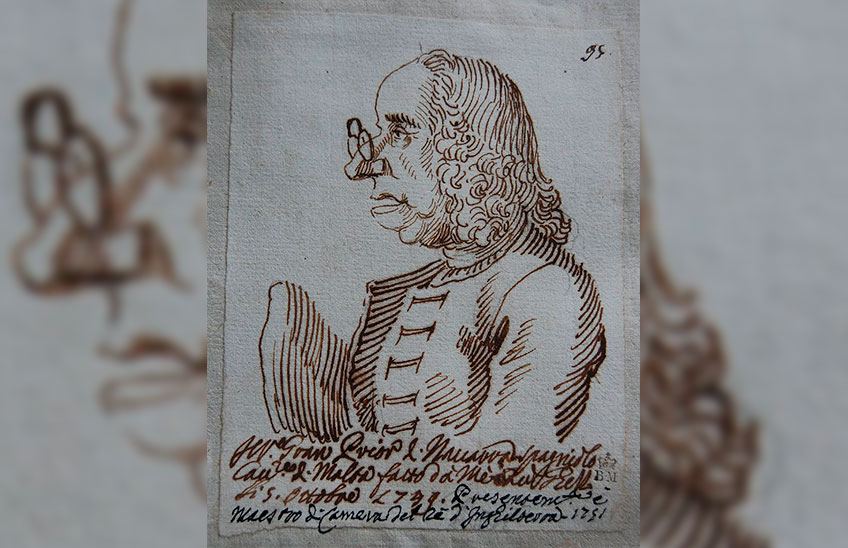The first caricature of a Navarrese in 1749

PhotoCaricatureof Don Antonio Escudero y Muro, taken in Rome in 1749. Photo Pier Leone Ghezzi. British Museum/
The origins of caricature and the genius of Bernini
The graphic caricature was born in the university city of Bologna at the end of the 16th century, in the school of the Carracci. As a genre of drawing, it represents a portrait with exaggerated facial and behavioural features, in order to produce laughter or to ridicule situations of various kinds. The students of the aforementioned academy amused themselves by making caricatures of visitors in the guise of animals or inanimate objects, but they generally did so for private use, without the malice of satire that the genre would acquire centuries later.
However, caricature, from the Italian "caricare", is a child of the Baroque. Bernini's multifaceted genius was admired at the papal court for his skill ability to reflect the essence of people. The master defined caricature as "an attempt to discover likeness in deformity, so that we come closer to the truth than to reality itself". Cardinals, knights and even the pontiff himself passed through Bernini's eye.
Subsequently, interest in caricature grew in Europe and later in the United States. Tiepolo and Goya made their forays into caricature, but it was not until the 19th century that the great names linked to satirical publications emerged.
A Corellan from the Age of Enlightenment: Don Antonio Escudero y Muro
One of the most distinguished Corellans was Don Antonio Escudero y Muro, who became Grand Prior of the Order of Jerusalem in Navarre, commander of Philip V's Windward squadron and Steward in Rome to James III, pretender to the throne of England. Don Antonio was born in Corella in 1690, took the habit of Malta at an early age, in 1701, and professed in that Order in 1707, which he served militarily. In 1716, he was granted the command of Leache and later others, and soon after he went on to serve in the Spanish navy, performing valiant actions in 1718 in Sicilian waters. In 1719 he was promoted to frigate captain, in 1721 to ship captain and in 1726 he was given command of the Windward Squadron, in charge of suppressing smuggling in the West Indies. In 1740, on the occasion of the War of the Austrian Succession, he was ordered to arm his ships in Malta in privateering against the English, but as the Order of St. John maintained a position contrary to that of the King of Spain, he was unable to obey and was relieved of his command position.
In 1741 he was appointed Grand Prior of the Order of St. John in Navarre and, shortly afterwards, Admiral of the Malta Squadron. At that time, in the struggles of James III to seize the English throne, the Order of Malta helped the pretender and Don Antonio intervened with his squadron to that end, becoming his steward, position where he remained until 1766, when James Stuard died. Don Antonio died in 1770, aged eighty. In Malta, a funeral monument was dedicated to him at report, of which a contemporary drawing is preserved.
His caricature by the great master Ghezzi in 1749
The author of the caricature of Don Antonio is Pier Leone Ghezzi (1674-1755), a famous Italian painter, author of numerous official portraits of the Rome of his time and son-in-law of the painter Carlo Maratta. He owes his greatest fame to his numerous caricatures of people of all kinds subject that he painted in the Rome of his time, including prominent prelates, nobles, artists, pilgrims and visitors to the Eternal City. In all of them, as Bernini recommended, the physical features of the figures' faces are exaggerated with skill. The British Museum has an album that entered its collections in 1859, which contains a large number of caricatures by Ghezzi. Despite his social position, Ghezzi did not disdain to portray visitors to Rome for a small fee. One of the caricatures is that of Antonio Escudero.
The most accentuated features of the caricature, as is usually the case in others, are the nose on which the quevedos are mounted and the large, half-open mouth. He has a clear forehead with incipient baldness typical of his age at the time - fifty-nine - and long hair, and wears a jacket. This is possibly the first known caricature of a Navarrese.
To find out more
BERNINO, D., Vita del Cavalier Gio. Lorenzo Bernino (1713), Perugia, Ediart, 1999.
CHANTELOU, P. F., Diario del viaje del caballero Bernini a Francia, Madrid, high school de Conservación y Restauración de Bienes Culturales, 1986.
